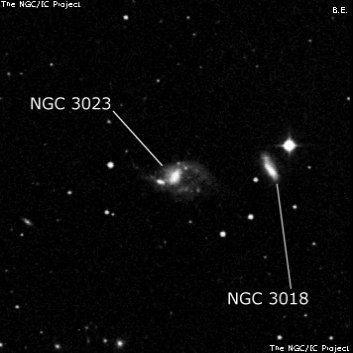NGC/IC Project Restoration Effort
(This is a very very beta version)
NGC3023


Basic Information
Location and Magnitude
Right Ascension: 9:49:52.6
Declination: +0:37:8
Constellation: SEX
Visual Magnitude: 12.3
Historic Information
Discoverer: Stephan
Year of discovery: 1880
Discovery aperture: 31.0
Observational
Summary description: pF, pL, iR, lbM, dif
Sub-type: SBc/P
Steve's Notes
=====
NGC 3023
48" (4/7/13): at 375x appeared very bright, large, irregular, asymmetric with a bright, slightly elongated central region, ~40"x30". Extending to the west of the core is large, faint halo or loop, most evident on the north side of the loop, which is brighter and more sharply defined as it sweeps to the west towards companion NGC 3018. The loop extends the diameter to ~1.7'. Mrk 1236, is a very small, but very high surface brightness companion attached on the east side of the core. LEDA 1170217 = MAC 0950+0035 was picked up in the field, 4.4' ESE. It appeared faint (V = 16.6), small, slightly elongated, 15"x10", low even surface brightness.
48" (4/2/11): at 375x this bright, interacting galaxy has a very unusual, asymmetric appearance. The central region is bright, oval 4:3 NNW-SSE, 40"x30", increases evenly to a very small, very bright nucleus. A larger, outer halo extends mainly to the west. The halo extends from the central region ~1' in a loop and is brightest along the rim, particularly looping from the north side of the core counterclockwise to the west [the DSS reveals this feature is a spiral arm]. This arm gives the visual impression of a partial ring extending the west of the core.
A bright companion, Mrk 1236, is attached within the small halo on the east side of the core, just 25" ESE of center. This Wolf-Rayet galaxy appeared moderately bright, very small, elongated 2:1 E-W, ~16"x8", very high surface brightness. On the SDSS image this object is resolved into several clumps or knots. NGC 3018 lies 2.8' W of center. Located 3.4' ESE of mag 9.7 HD 85095.
17.5" (2/8/91): fairly faint, fairly small, slightly elongated 4:3, broad concentration in halo but no nucleus. A faint star or knot is visible on the east end. Forms a pair with NGC 3018 3' W and also 3.4' ESE of a mag 10 star. This is a double system which was probably resolved in the observation as a faint star or knot on the east end (Mrk 1236)!



